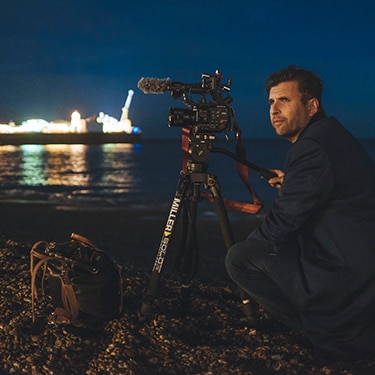Nuit de la Glisse: Filming under pressure with FS7
Whether it’s an off-piste ski jump from a helicopter or a 30-feet underwater free dive, director Thierry Donard and cameraman Simon Favier know exactly how to catch the ‘perfect moment’, with the help of Sony’s PXW-FS7 and PXW-FS5. Host Dan Chung discusses the technical and creative challenges of extreme sports filmmaking with director/film-maker Thierry Donard and cameraman Simon Favier.
The project
Don’t Crack Under Pressure is a feature-length documentary from extreme sports filmmakers Nuit de la Glisse. Filmed on location in some of the world’s most extraordinary settings, the film presents 15 extreme sports professionals showcasing their talent in stunning 4K.
“Most of it is extreme sports, (but) always with the same way of thinking,” cameraman and ex-professional snowboarder Simon Favier told us. “It’s not about competition, it’s about state of mind, and enjoying what you do in beautiful places.” One of the most remarkable sequences features two wingsuit freeriders jumping from a helicopter above the French Alps and landing in the Italian Alps – this was filmed using two FS7 cameras, one mounted on the head of a rider.
“He passes me by very close… you can see he’s 70 metres above my head,” director and founding member of team Thierry Donard recounted. “I’m static and I pan the camera over (as he passes). You can’t have a tripod for this; you can’t move as quick.”
The set-up
The Nuit de la Glisse crew is made up of between 10 and 15 members during production. This includes Thierry as director of photography, Simon as technical director and cameraman, several PXW-FS7 operators, one sound engineer, one director of photography assistant, several local guides, and one handheld PXW-FS5 cameraman, who is often shooting behind the scenes.
“Normally we take three or four cameras,” Thierry explained. “Including a POV camera operator dedicated to make sure everything is going well with the right angle on everything.”
“For a normal day filming in the mountains, or even surfing, we wake up at 4am and we finish at night,” Simon said. “It’s such a long day.”
“The demand is to have a small, compact camera that’s not too heavy, and with a small lens,” Thierry continued. “This is what we found in the FS7.”
The PXW-FS7 was the main camera in operation during production, and the crew pushed it to its limits.
“You can put four lenses, plus the camera and battery in your backpack for the day,” Simon explained. “In -30 degrees the camera still works and in 40 degrees the camera still works. It’s a really practical camera.”
Acrobatic kite-boarding sequences look spectacular, but required a 4am start
4K XAVC
“4K is essential to selling your film. HD is done,” Thierry said, stating how important pre-sales and distribution were to the film’s success. “We want the best quality.” Achieving the best possible 4K quality in such demanding environments with an incredibly gruelling schedule is no small task.
“The problem with RAW is the time it takes to de-log,” Thierry said. “When you are on a boat or in the jungle, we have no time to de-log the camera.”
So rather than use RAW, the team relied upon Sony’s XAVC codec and S-Log to capture their 4K content with extraordinary quality, while keeping file sizes manageable and enabling a fast, effective workflow for reviewing and backing up content while on the move. Dealing with hours of uncompressed RAW footage in such remote locations simply wouldn’t have been practical for the small team.
“What is the best? To be able to move quickly, capture the scene, the essence and the spontaneous moment, or to get all the best gear, set up, get ready and then it’s gone?”
“When you see the results coming through the cinema,” Thierry continued, “or seeing the film on Vimeo, you will see shooting with a codec works.”
It's not about competition, it's about state of mind, and enjoying what you do in beautiful places.
Simon Favier
Cameraman and ex-professional snowboarder
